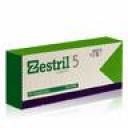Diabetic nephropathy is the most frequent cause of end-stage kidney disease in the United States, Europe and Japan. Large scale randomized controlled trials have shown that both ACE inhibitors and angiotensin II receptor antagonists reduce microalbuminuria, slow rate of decline of GFR and delay end stage kidney disease.
The renin-angiotensin system plays a significant role in the human inflammatory process in addition to its well known effects on blood pressure and sodium homeostasis. The role of angiotensin II as a pro-inflammatory cytokine may be important in understanding the role of the renin/angiotensin/aldosterone axis in diabetic kidney disease.
The effect of angiotensin II on the physiology of the heart, blood vessels and kidneys begins when low renal perfusion pressure in the juxtaglomerular apparatus triggers renin release from the renal cortex, catalyzing the conversion of angiotensinogen to angiotensin I. Angiotensin I is converted to angiotensin II via the action of angiotensin converting enzyme (ACE). Angiotensin II then serves to increase sympathetic activity, reabsorb sodium and cause peripheral vascular constriction. Disorders of this system are now known to play an important role in the pathophysiology of hypertension, congestive heart failure, and renal disease. I will explore some new concepts regarding the role angiotensin II plays in diabetic kidney disease and why preventing its action results in delay of progression of diabetic nephropathy to end stage kidney disease.
Vascular tone is generally mediated by vasodilators such as nitric oxide (NO) and vasoconstrictors such as angiotensin II. The balance between NO and reactive oxygen species play an important role in normal endothelial function. Besides promoting vasodilatation, NO also is an inhibitor of vascular smooth muscle cell growth and migration, and expression of NF-kappaB and other pro-inflammatory molecules.
In addition to its well-known physiologic actions, angiotensin II is also itself a major mediator of oxidative stress and an antagonist of NO. Angiotensin II induces reactive oxygen species such as superoxide and hydrogen peroxide. It stimulates cytokines such as interleukin-6, tumor necrosis factor-alpha, VCAM and NF-KappaB. Inflammatory cells such as granulocytes, monocytes and macrophages have themselves been found to be potent producers of ACE, the enzyme which further induces angiotensin II production. This induction creates a positive feedback loop for local tissue inflammation.
Given the above ways that angiotensin may cause pathological states, blockage of the angiotensin converting enzyme makes a logical therapeutic target. Since ACE degrades kinin, its blockade by ACE inhibitors not only down regulates angiotensin II and all of its pro-inflammatory properties, but also serves to increase bradykinin levels. In turn, through NO and prostacyclin induction, bradykinin lowers blood pressure and exerts an overall anti-inflammatory effect.
Renal fibrosis is the abnormal accumulation of extracelluar matrix in normal kidney structures, which is the result of failed wound healing of kidney tissue following chronic sustained injury. In diabetics, glomerular lesions and renal vascular arteriosclerosis induce this chronic injury. TGF-beta secretion, stimulated by angiotensin II, is initiated by these events and ultimately leads to, vasoconstriction and extracellular matrix deposition. Angiotensin II is thus an important component in the progression of renal fibrosis.
Boffa et al studied the exaggerated gene and protein expression of TGF-beta, collagen I and collagen IV within the renal vasculature of mice with renal failure. The angiotensin II receptor antagonist losartan was administered, and after one week there were decreased collagen I, collagen IV, and TGF-beta gene expression. At four weeks the investigators reported regression of glomerulosclerosis, partial restoration in renal function, normalization of histological parameters and a decrease in mortality. This study suggested that in mice, through angiotensin II receptor blockade, collagen synthesis and renal fibrosis can be mitigated.
Humans are different than mice and the effects of ACE inhibitors and angiotensin receptor blockers are not as dramatic in human subjects. There is still reason to suggest that similar pathways exist in the progression of human renal fibrosis. Regardless of the mechanism, blocking the action of angiotensin II has the ability to slow the progression of end stage kidney disease in our patients. Older concepts regarding the effects of ACE inhibitors and ARBs to dilate the efferent arteriole and lower glomerular capillary pressure may still be operating in the drugs’ effects, but their effects on inflammation and fibrosis may be more important. The future of therapy for diabetic nephropathy likely lies in finding new mechanisms to dampen the inflammatory responses of the kidney.
Reference:
1. Maschio G, Alberti D, Janin G, Locatelli F, Mann JFE, and the AIPRI Study Group: Effect of the angiotensin-converting enzyme inhibitor benazepril on the progression of chronic renal insufficiency. N Engl J Med334 : 939-945,1996.
2. Dzau VJ. Theodore Cooper Lecture. Tissue angiotensin and pathobiology of vascular disease: a unifying hypothesis. Hypertension. 2001; 37: 1047–1052.
3. Kranzhöfer R, Schmidt J, Pfeiffer CAH, Hagl S, Libby P, Kubler W. Angiotensin induces inflammatory activation of human vascular smooth muscle cells. Arterioscler Thromb Vasc Biol. 1999;19:1623–1629.
4. De Caterina R, Libby P, Peng HB, Thannickal VJ, Rajavashisth TB, Gimbrone MA, Shin WS, Liao JK. Nitric oxide decreases cytokine-induced endothelial activation: nitric oxide selectively reduces endothelial expression of adhesion molecules and proinflammatory cytokines. J Clin Invest. 1995;96:60–68.
5. Remuzzi, Giuseppe, Schieppati, Arrigo, Ruggenenti, Piero Nephropathy in Patients with Type 2 Diabetes N Engl J Med 2002 346: 1145-1151.
6. Gerstein HC, Yusuf S, Mann JF, Hoogwerf B, Zinman B, Held C, et al. Effects of ramipril on cardiovascular and microvascular outcomes in people with diabetes mellitus: results of the HOPE study and MICRO-HOPE substudy. Heart Outcomes Prevention Evaluation Study Investigators. Lancet 2000;355(9200):253-9.
7. Chatziantoniou: Curr Opin Nephrol Hypertens, Volume 17(1).January 2008.76–81.
8. Boffa JJ, Ying L, Placier S, Stefanski A, Dussaule JC, and Chatziantoniou C. Regression of renal vascular and glomerular fibrosis: role of angiotensin II receptor antagonism and metalloproteinases. J Am Soc Nephrol 14: 1132–1144, 2003.
Reviewed by David Goldfarb, M.D. Professor of Medicine, NYU Medical Center, Chief Nephrology Section VA New York Harbor

